The Essential Guide to Slip Resistant Bathtub Mats


Intro
When it comes to enhancing safety and comfort in your bathroom, the humble bathtub mat often flies under the radar. These items are not just a mere decor piece but serve a crucial function in preventing slips and falls during one of life’s most relaxing activities. With baths being a place for unwinding and soaking away stress, it's vital to ensure that every element within that space contributes to a safe and enjoyable experience.
This guide will explore various aspects of slip-resistant bathtub mats, from the materials they’re made of to their design options and maintenance. We'll also delve into safety standards to arm you with the knowledge needed to choose the right mat for your home. It’s all about making an informed choice that prioritizes both functionality and aesthetic appeal in your bathing sanctuary.
The Importance of Slip-Resistant Mats
Slip-resistant mats are a game changer, particularly in homes with children, elderly individuals, or anyone with mobility challenges. The risk of falls in bathrooms is no joke—statistics suggest that nearly 234,000 injuries related to bathing occurred in the United States alone in recent years!
By incorporating slip-resistant mats, you not only protect your loved ones but also enhance the overall ambiance of your bathroom. Think about it: a mat that not only keeps you safe but also complements your tile and paint choices is a double win.
An essential factor to keep in mind is the certification of slip-resistant mats. Certain standards exist, like the American National Standards Institute (ANSI) that test products for traction under wet conditions. Not all mats are created equal, so knowing what to look for can save you from potential mishaps.
Materials Matter
When selecting a slip-resistant mat, the material plays a vital role in its effectiveness. Here are some common materials used:
- Rubber: Known for its durability and excellent grip, rubber mats are a popular choice. They often have textured surfaces designed to keep users stable.
- Vinyl: These mats are lightweight and come in various colors and patterns, making them a versatile option. Vinyl is generally water-resistant and easy to maintain, which is a big plus.
- Microfiber: Beyond aesthetics, microfiber mats absorb water effectively while providing a soft landing underfoot, avoiding cold tile surprises.
Keep in mind that not all these materials behave the same way when wet. Always examine how the mat feels when damp—after all, a mat that’s slippery when wet defeats its purpose.
Designing for Style and Safety
Choosing a slip-resistant mat does not mean compromising on style. In fact, today's market offers a bevy of options that merge safety with aesthetic appeal. From farmhouse chic to modern minimalist looks, there is something for every taste.
Consider the following tips when searching for the right design:
- Color Coordination: Match your mat with your bathroom hues to create a cohesive look. A pop of color can brighten an otherwise dull space.
- Shape and Size: Tailor the mat’s shape and size to fit your tub or shower configuration. Round, rectangular, or even custom shapes can add unique flair.
- Texture: Some mats come with textured designs that can add visual intrigue while enhancing grip.
Utilizing these design elements can ensure that your safety additions blend seamlessly into your existing aesthetic.
Maintenance for Longevity
Like any item in your home, slip-resistant mats require maintenance to stay effective. Here are tips to keep them in good shape:
- Regular Cleaning: Clean mats weekly with a gentle detergent to remove mold and mildew. Hot water can also be effective in displacing pesky germs.
- Dry Thoroughly: After each use, it’s wise to let the mat dry completely. Leaving it damp can lead to the very slips you’re trying to avoid!
- Check for Wear and Tear: Periodically inspect your mats for any signs of wear. Replace mats that have lost their grip or show extensive damage.
"A stitch in time saves nine; addressing issues early helps maintain safety and comfort in the long run."
By following these preventative measures, you can extend the life of your slip-resistant mat while keeping your bathroom safe.
The End
Choosing the right slip-resistant bathtub mat is more than a simple home improvement task. It’s about making conscious choices that prioritize both safety and style within your sanctuary. Understanding the materials, designs, and necessary maintenance allows homeowners and designers alike to cultivate a safe bathing environment without sacrificing aesthetics. By embracing informed decision-making, you craft a bathing experience that resonates with comfort and security.
Preamble to Slip Resistant Bathtub Mats
In the contemporary whirlpool of home design and functionality, the importance of safety cannot be overstated, especially in wet areas such as bathrooms. As a quiet sanctuary within our personal spaces, the bathtub is where many seek solace, but it can also become a site of potential accidents. This is where slip-resistant bathtub mats come into play, offering both a practical solution for safety and an opportunity for enhancement of the home’s aesthetic appeal.
The Necessity of Safety in Baths
Baths should be relaxing, a retreat from the hustle and bustle of daily life. However, according to the National Safety Council, slips and falls in bathrooms are among the most common causes of injuries in the home. It's not just the elderly who need to be cautious; individuals of all ages can find themselves in precarious situations when water and slick surfaces collide.
The importance of safety in these spaces cannot be ignored. Choosing a quality slip-resistant mat can drastically reduce the risk of falls, providing a textured surface that enhances grip, even when wet. The peace of mind that comes with knowing you can step safely in and out of the tub is invaluable, creating an environment where one can truly unwind without worry.
The Role of Bathtub Mats in Home Safety
Bathtub mats serve several critical functions in ensuring home safety. They do more than simply catch water; they are a first line of defense against slips. Often crafted with materials designed to remain stable on wet surfaces, these mats can adhere strongly to the bathtub's bottom or floor.
Moreover, slip-resistant mats can tailor their roles based on different household needs. For families with young children or elderly members, a well-chosen mat can dramatically cut down on the likelihood of accidents. Additionally, they prevent water from spilling onto the floor, reducing the risk of slips outside the bathtub area too.
When properly chosen, a slip-resistant mat can seamlessly blend into the bathroom's design, becoming a part of the decor while serving its safety purpose. This dual functionality enriches the entire bathing experience, showcasing that safety doesn't have to sacrifice style.
"Safety should never be an afterthought, especially in personal spaces where relaxation is key."
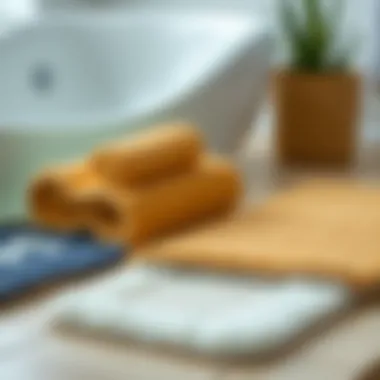
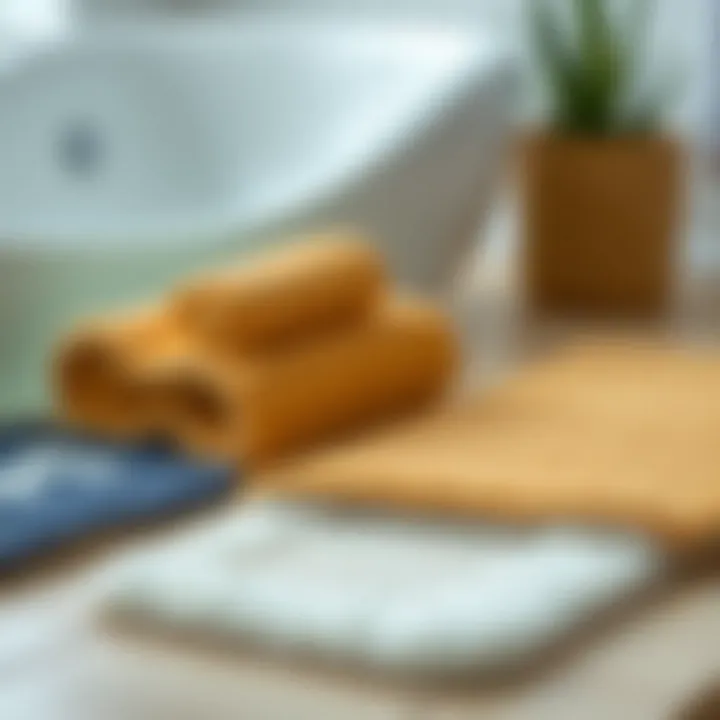
A slip-resistant bathtub mat will not only enhance safety but can also become a design statement—an intersection of practicality and artistry in home decor. When one makes informed decisions about these products, they become pivotal in ensuring a secure and inviting environment for everyone.
Material Types for Bathtub Mats
When it comes to choosing the right bathtub mat, the material plays a crucial role. Different materials not only impact the grip and safety of the mat but also its durability, aesthetic appeal, and maintenance requirements. Understanding the various material types allows homeowners and decorators to make informed decisions that align with their safety standards and design goals.
Rubber Mats: Benefits and Drawbacks
Rubber mats are often hailed as the heavyweight champions in the slip-resistant mat category. Their naturally high friction surface ensures that even wet conditions won’t make them budge. They are incredibly durable and often last for years without showing signs of wear.
- Benefits:
- Drawbacks:
- Excellent traction with a robust grip.
- Resilient against moisture, making it difficult for mold and mildew to thrive.
- Easy to clean; many can simply be rinsed or wiped down.
- Some may find the rubber smell off-putting initially.
- Can be heavier than other types, which might be inconvenient during cleaning.
- The matte finish could clash with more luxurious bathroom designs.
In summary, rubber mats are ideal if your priority is safety and longevity, but you may have to compromise a bit on aesthetics.
Vinyl Mats: An Overview
Vinyl mats offer a lightweight and cost-effective alternative. They are manufactured using a synthetic polymer that provides decent slip resistance but may not match rubber in terms of grip. While vinyl isn't as robust, it brings a different set of benefits to the table.
- Benefits:
- Drawbacks:
- Available in a wide variety of colors and patterns, giving you the chance to match any bathroom decor.
- Lightweight and easy to handle, which is a plus for frequent cleaning.
- Generally less expensive than rubber mats, making them a budget-friendly choice.
- Over time, they may wear down and lose their slip-resistant properties.
- Tend to be less effective in preventing slips in wet conditions compared to rubber.
- May require more maintenance to avoid discoloration and wear-out.
Vinyl mats can suit those who prioritize aesthetics and cost but need to balance their choice with lower traction levels.
Cotton Mats: Comfort vs Functionality
Cotton mats are the go-to for those seeking comfort. Unlike their rubber and vinyl counterparts, cotton mats give that soft, cozy feel underfoot. They can be more absorbent, which adds to their appeal.
- Benefits:
- Drawbacks:
- Super comfy; they provide a warm touch that’s easy on the feet.
- Absorb moisture, making them great for catching dripping water.
- Machine washable, which can be convenient for upkeep.
- They generally lack effective slip-resistance properties, especially when wet.
- Can harbor mold or mildew if not properly dried and cared for.
- Might not hold up as long as rubber or vinyl in wet environments.
In essence, while cotton mats can make your bathing experience cozy, they might not be the best choice for safety, especially if your bathroom is often humid.
Understanding the materials available helps in not just preventing slips but in creating a bathing space that looks good, feels good, and works well. For a deeper dive into bathroom safety, you can visit resources like Wikipedia or Consumer Reports.
Design and Aesthetic Considerations
The choice of slip resistant bathtub mats extends beyond mere functionality into the realm of aesthetics and personal expression. Homeowners often overlook how vital this segment of bathroom design can be, but striking a balance between safety and style is essential. A bathtub mat is not just a tool against slips; it can also enhance the overall atmosphere of the bathing environment. Understanding the design aspects, from color choices to how they mesh with existing decor, can transform a mundane bathroom into a delightful sanctuary.
Color and Pattern Choices
When it comes to selecting a bathtub mat, color and pattern play a pivotal role. The visual appeal of a bathroom can be uplifted simply by pairing the right mat with the existing colors of walls, tiles, and other fixtures. The choices are virtually endless: vibrant hues that make a statement, or subtle shades that create a calm vibe.
For instance, a blue mat with abstract wave patterns might evoke a sense of serenity reminiscent of ocean waves, which is perfect for a coastal decor scheme. On the other hand, a bold red mat with geometric shapes might serve as a stunning focal point in a minimalist bathroom design. The key is to ensure that the pattern complements rather than clashes with other elements present.
"The first impression can be a lasting one, and the visual appeal of bath mats can set the mood long before any soap hits the water."
Size and Fit for Different Bathtubs
Not every bathtub is created equal, and neither are mats. Selecting the right size is crucial to ensure both safety and aesthetics. A mat that is too small may not cover the necessary area, failing to provide needed slip resistance. Conversely, a mat that's too large could overwhelm the space and appear awkward.
Measuring your bathtub before shopping is an invaluable step. Rectangular tubs might call for elongated mats, while a freestanding tub could benefit from smaller, circular options. Aside from practicality, size also ties into style; a well-fitted mat can contribute to a cohesive, polished look. Think about how different sizes can accentuate or detract from the beauty of your bathing space.
Matching Mats with Bathroom Decor
Every homeowner dreams of a harmonious environment, and the bathroom should be no exception. When choosing slip resistant mats, consider the overall theme of your bathroom as well as the materials already in play.
If the existing decor includes wooden fixtures, opting for a mat that ties in natural colors might enrich the aesthetic appeal. Alternatively, if the space leans toward contemporary, materials that sport sleek designs can elevate the modern vibe.
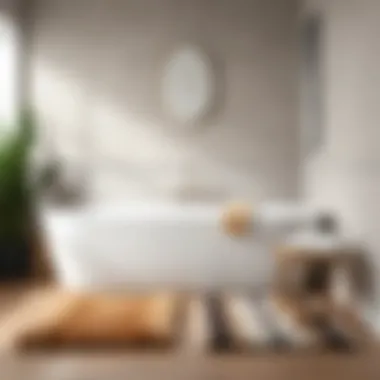
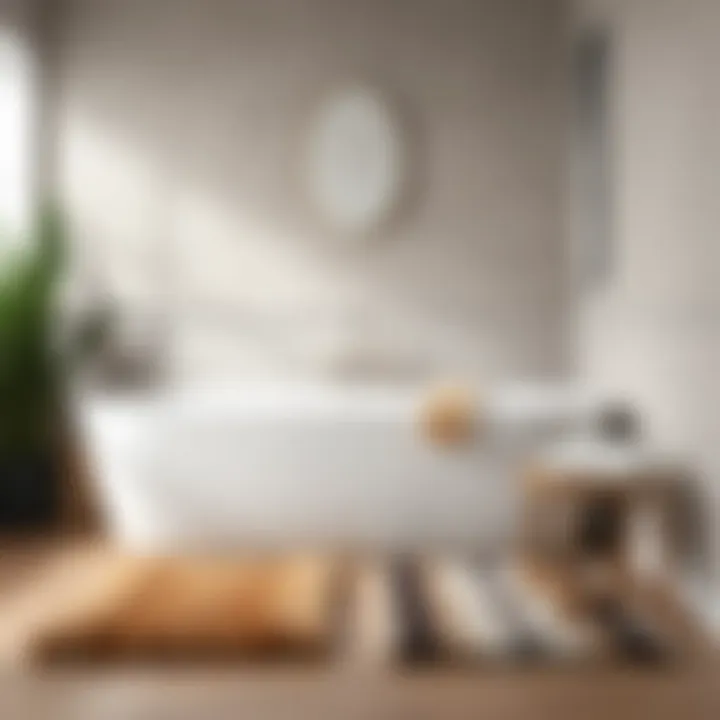
Here are a few pointers for pairing mats with your decor:
- Assess the Color Scheme: Keep a consistent palette or strategically introduce contrast through your mat.
- Consider Material: A cotton mat can soften a sharp-looking bathroom, while a rubber mat might add a more industrial feel.
- Reflect the Theme: Whether your bathroom is vintage or ultra-modern, ensure the mat aligns with that vision.
Evaluating Safety Features
When it comes to ensuring safety in bathing environments, evaluating safety features of slip-resistant bathtub mats is paramount. The right mat can turn a potentially dangerous situation into a safe and comfortable experience, especially for vulnerable individuals such as children or the elderly. In this section, we will delve deeper into key aspects that every homeowner, designer, and realtor should consider when selecting slip-resistant mats.
Understanding Slip Resistance Ratings
Slip resistance ratings provide essential information on how effective a mat will be at preventing slips and falls. These ratings are typically derived from standardized tests that measure the coefficient of friction (COF) under different conditions. A higher COF indicates a greater level of slip resistance, which is a crucial factor in the choice of a bathtub mat.
Generally, ratings can range from low to high, with classifications such as:
- DCOF (Dynamic Coefficient of Friction): Primarily measured when a person is in motion, indicating how well a mat can grip the foot.
- WC (Wet Coefficient): Relevant when the mat is wet, mimicking real bathroom scenarios.
- Dry Coefficient: Relevant when the mat is used in dry conditions, which can be less important for bath use but still relevant for evaluating overall grip.
It's wise to look for mats that offer ratings classified as 'high' or 'very high'. Products boasting a DCOF of at least 0.42 typically indicate better safety, helping to mitigate slip risks significantly in wet environments.
Moreover, it would be prudent to regularly check that the ratings comply with local safety regulations or standards.
Comparing Different Brands
Not all bathtub mats are created equal, and that holds particularly true when it comes to safety features. While a brand may market their products as slip-resistant, one must dig deeper to ensure they truly meet safety needs. Here are a few parameters to consider when comparing brands:
- Certification: Check if the product comes with relevant certifications by respected authorities or organizations that focus on safety and testing.
- Customer Feedback: Delve into customer reviews and forums like Reddit or Facebook, where real users share their experiences. Look for feedback on durability, comfort, and actual safety performance.
- Materials Used: The quality of materials and the manufacturing process behind the mats can considerably affect their performance. Brands like Gorilla Grip and Rubber Bath Mat are known for their slip-resistant properties, derived from high-quality materials, whereas more budget-friendly options may not offer the same level of safety and durability.
- Warranty and Return Policy: A longer warranty often suggests confidence in the brand’s product. If something goes wrong, a good return policy is also helpful for ensuring customer satisfaction.
In summary, understanding slip resistance ratings and comparing safety features across brands will empower consumers to make informed choices. This diligence not only simplifies selection but also promotes a safer environment for those who utilize the bathing space.
Maintenance and Care Instructions
Maintaining slip-resistant bathtub mats is essential for ensuring their longevity and ongoing effectiveness. Proper care not only enhances the safety features of these mats but also keeps them looking fresh and clean, making your bathing experience more enjoyable. In dealing with something as critical as bathroom safety, neglecting maintenance can lead to premature wear or, worse yet, reduced slip resistance over time.
A clean mat resists mold and mildew build-up, ensuring it stays hygienic, while regular maintenance can prolong its lifespan. Homeowners should make it a habit to inspect their mats periodically, looking for signs of damage or wear. Ignoring these checks could lead to accidents, which is the last thing anyone wants in a slip-prone area like a bathroom.
Cleaning Techniques for Longevity
Keeping your slip-resistant mat in good shape comes down to effective cleaning practices. Here are some recommended techniques that can promote longevity:
- Regular Washing: Depending on usage, a thorough wash every couple of weeks can work wonders. Depending on material, washing might include just a hose down, or putting it in the washing machine if it’s cotton or machine-washable vinyl.
- Mild Detergents: Always opt for mild detergents to avoid chemical damage. Harsh cleaning agents can wear down the mat's texture and erode its slip-resistant qualities.
- Baking Soda and Vinegar: These household staples can help in tackling stubborn grime. Create a paste with baking soda, leave it on for a bit, then rinse with vinegar. The reaction will help lift any debris while being gentle on the mat.
- Drying Thoroughly: After washing, ensure that the mat is completely dry before placing it back in the bathtub. A damp mat is a breeding ground for mold.
"An ounce of prevention is worth a pound of cure.”
Storing Mats to Prevent Damage
When not in use, how you store your bathtub mats matters just as much as how you clean them. Improper storage can lead to curling, fading, or discomfort during the next use. Consider these storage tips:
- Keep it Flat: If possible, roll the mat up flat rather than folding it. This prevents creases, which can lead to wear and tear.
- Avoid Direct Sunlight: Store them in a shaded area to prevent fading. Prolonged exposure to UV rays can diminish vibrant colors.
- Store in a Dry Place: Keeping the mat in a damp area when not in use encourages mold – which we should all work hard to avoid.
- Use Storage Bags: If you have limited space, consider using breathable storage bags. It keeps dust and dirt away but allows for air circulation.
Incorporating these cleaning techniques and storage practices will not only safeguard your slip-resistant mats but will also ensure your home maintains a clean and safe bathing environment for all family members.
Common Misconceptions About Slip Resistant Mats
When it comes to slip-resistant bathtub mats, a handful of common misconceptions tend to muddle the waters. These misunderstandings can lead to poor decisions regarding safety that can affect everyone in the household, especially young children and the elderly. Therefore, taking the time to address these myths is essential for making the right choice in your bathroom safety strategy.
Misunderstanding Effectiveness
One of the biggest misunderstandings surrounding slip-resistant mats is the idea that all mats inherently provide the same level of safety. This belief can be misleading. Not all slip-resistant mats are created equal; they vary widely in their effectiveness based on several factors such as material composition, surface texture, and design.
Many consumers believe that a mat labeled as "slip-resistant" guarantees complete safety, which simply isn't true. This misconception can lead to a false sense of security. For example, a mat made from low-quality rubber might slip easily on certain bathtub surfaces, defeating its intended purpose. Therefore, before making a purchase, it’s crucial to verify product specifications and slip resistance ratings to ensure they meet safety standards.
Besides, many people overlook the significance of proper installation. If a mat is not placed correctly or is allowed to accumulate dirt and mildew, it can lose its grip significantly over time. Regular cleaning is essential not just for aesthetics, but also for maintaining its effectiveness.
"Understanding the limits of slip resistance helps in making informed decisions that lead to safer bathing experiences."
Aesthetic Limitations
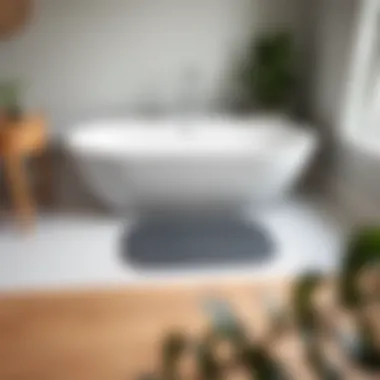
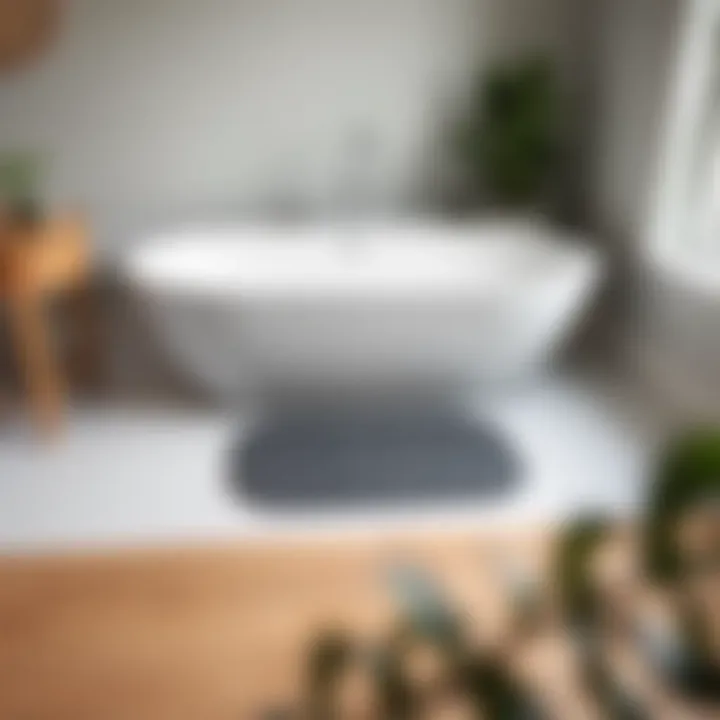
Another common myth is that slip-resistant mats are bulky or unattractive, leading homeowners to avoid them even when they need extra safety. This misconception is rooted in outdated designs that many people still associate with functional safety products. However, contemporary slip-resistant mats are available in a vast array of colors, patterns, and designs that can complement any bathroom decor.
Homeowners often think that choosing a highly effective mat means sacrificing visual appeal, but that is not necessary anymore. For instance, companies now offer beautiful mats that blend seamlessly into bathroom aesthetics without looking out of place.
There’s an increasing demand for items that look great while still serving their purpose, and manufacturers are stepping up to the challenge. This way, an eye-catching design doesn’t have to be at odds with safety features; in fact, they can go hand in hand.
Legal and Regulatory Aspects
Understanding the legal and regulatory framework surrounding slip-resistant bathtub mats is crucial for manufacturers, consumers, and designers alike. This landscape is not just about ensuring that products are safe; it encompasses compliance with safety standards, consumer rights, and liability issues that can affect every stakeholder in the market.
One of the foremost elements in this discussion is compliance with safety standards. These standards are designed to protect consumers by establishing minimum acceptable criteria for slip resistance and material safety. Adhering to these regulations not only promotes consumer trust but also shields companies from potential legal repercussions. If a mat fails to meet these requirements and results in an injury, both manufacturers and retailers could face serious consequences.
In many countries, regulatory bodies like the American National Standards Institute (ANSI) or the Consumer Product Safety Commission (CPSC) set guidelines that products must follow. For instance, a bathtub mat labeled as "slip-resistant" should undergo rigorous testing to substantiate that claim. Manufacturers must thus invest in proper testing to ensure their products align with these essential criteria. A failure in this aspect can lead to lawsuits that attribute liability to the supplier in case of accidents.
Moreover, it becomes increasingly vital for consumers to understand their rights regarding these products. When purchasing a bathtub mat, buyers are entitled to certain protections, allowing them to expect that the product is safe and meets the advertised specifications.
"Awareness of safety standards is not just a consumer issue; it’s a lifeline that holds manufacturers to accountability."
Standards for Safety and Compliance
Standards for safety and compliance ensure that slip-resistant bathtub mats are not just promotional gimmicks, but products that deliver real benefits to users. These standards often assess several factors, including the material’s grip potential, durability, and ability to resist water and mold.
The slip resistance of a bathtub mat can be quantified through testing, typically using a standardized testing method, such as the ASTM F1677. This evaluates the coefficient of friction when tested on wet surfaces. By adhering to these criteria, manufacturers can provide assurance to consumers that their mats can help prevent slips and falls - critical considerations in domestic environments.
Familiarizing oneself with these standards can guide consumers to make enlightening choices, helping them select mats that live up to their safety claims. Importantly, compliance with national regulations can also empower designers and architects to incorporate these mats confidently into their projects. Ensuring that all necessary certifications are obtained can enhance the marketability of these mats as reputable solutions within modern bathrooms.
Consumer Rights and Product Liability
An important aspect of legal considerations surrounding slip-resistant bathtub mats pertains to consumer rights and product liability. Consumers have the right to expect that products, such as bathtub mats, are inherently safe when used as intended. This expectation creates an unspoken contract between buyers and sellers, holding the latter accountable for the quality and safety of what they market.
In recent years, the awareness surrounding product liability has grown significantly. If a slip-resistant mat fails to provide sufficient grip and leads to an injury, the injured party may have grounds to pursue a claim against the manufacturer. This could include factors like negligence in testing or failing to adequately warn consumers about potential risks.
To navigate these waters, consumers must do their research. Reading reviews, checking for safety certifications, and looking into product recalls can provide valuable insights into the reliability of a brand.
Furthermore, if a consumer feels a product does not meet safety expectations, they have avenues for complaints, such as reaching out to consumer protection agencies or seeking recourse through legal channels. Understanding these rights not only empowers consumers but also ensures that companies prioritize safety and quality in their offerings.
Product Recommendations and Reviews
When it comes to choosing the right slip-resistant bathtub mat, having solid product recommendations and reviews is essential. This segment not only highlights top contenders within the marketplace but also helps readers navigate their options. By focusing on various brands and their unique offerings, one can weigh their pros and cons, ideally suited for individual needs. Such evaluations promote informed decisions, ensuring that safety doesn't take a backseat to comfort or aesthetics.
The safety of slip-resistant mats extends beyond just their effective performance; it encompasses user experience, durability, and ease of maintenance as well. Hence, it's vital to understand that what works best can vary based on different situations. With countless types of mats available, recommendations serve to streamline choices and highlight products that have successfully fulfilled consumer needs.
Top Performers in the Market
Several products have made a name for themselves in the realm of slip-resistant bathtub mats. These mats often blend safety features with appealing designs, thereby attracting a variety of customers. Some top performers include:
- Gorilla Grip Bath Mat: Known for its superior grip, this mat uses a strong suction technology that prevents slipping effectively. Many users rave about its extra-thick construction and variety of colors.
- Yimobra Original Bath Mat: This mat provides a larger surface area with thousands of suction cups beneath. It’s not just about safety; this option boasts luxury with its soft, quick-drying material.
- SlipX Solutions Bathtub Mat: With a unique design that combines both slip resistance and easy cleaning, this mat stands out. It's often praised for its size and ability to fit most standard tubs.
- Epica Anti-Slip Bath Mat: Offering a perfect balance between durability and comfort, the Epica mat also features heavy-duty suction to keep it firmly in place. Users frequently mention how easily it washes clean after use.
These suggested products have been scrutinized through customer reviews, emphasizing their reliable performance and longevity. When considering a mat, checking out user feedback can provide additional insight that may not be highlighted in standard product descriptions.
Value for Money Options
In the search for a slip-resistant bathtub mat, budget considerations often come into play. Fortunately, several options provide safety without breaking the bank. Affordable mats shouldn’t compromise on essential features, thus striking a balance between price and quality. Here are a few value-for-money choices:
- MAYSHINE Non-Slip Bathtub Mat: This mat is budget-friendly while offering impressive slip resistance. It also comes in various colors, making it a versatile choice for different bathroom decors.
- Kvsio Anti-Slip Bath Mat: Known for its affordable price point, this mat includes a solid grip, perfect for families or elderly individuals. Users have noted that it's easy to maintain and offers great value.
- HARRRRD Non-Slip Bath Mat: With a modern design, this mat offers sufficient grip and a soft texture, making it a popular option among budget-conscious consumers. Customers often comment on its ability to stay in place, even in slippery conditions.
These value-driven choices exemplify that consumers can find quality solutions without having to spend excessively. Overall, product recommendations tailored to safety requirements and budget can lead you to the right decisions in enhancing your bathroom environment.
Epilogue and Future Trends
The emphasis on slip-resistant bathtub mats in today's world cannot be overstated. As bathing areas remain a sanctuary for relaxation and rejuvenation, ensuring safety in this space is of utmost importance. This section delves into both the current landscape of safety innovations and how they are likely to shape the future of bathing safety standards.
Safety Innovations in Bathroom Products
Over the years, the evolution of materials and smart technologies has significantly transformed bathroom safety. Innovations in design focus on enhancing not just aesthetic appeal but also functionality. For instance, newer slip-resistant mats are incorporating antimicrobial properties that prevent the growth of mold and mildew, ensuring not just a safe environment, but a hygienic one too. The integration of textured surfaces is another highlight; these surfaces are engineered to increase friction when wet, greatly minimizing the risk of slips.
There’s also an intriguing shift towards smart mats equipped with sensors that can detect moisture levels or sudden changes in weight, alerting users if someone has fallen. These examples represent just the tip of the iceberg in the ongoing pursuit of safety. As these products continue to be refined, we can expect even more innovative solutions designed to protect and enhance the bathing experience.
The Evolution of Bathing Safety Standards
As consumers’ expectations grow, so too do safety standards. The evolution of regulations surrounding slip-resistant products reflects a broader societal shift toward prioritizing safety in all aspects of life. In recent years, organizations such as the American National Standards Institute (ANSI) have advocated for more rigorous testing methods, leading to clearer and more reliable slip-resistance ratings. These advancements empower consumers to make informed choices based on concrete data.
Moreover, new guidelines are emerging that address the specific needs of various demographics, such as elderly individuals or those with mobility challenges. For example, product lines are being tailored to consider wider and gently contoured edges to accommodate users with limited balance or strength. By employing a more nuanced approach to safety, stakeholders across the board—from manufacturers to retailers to consumers—are working together towards a shared goal: a safer bathing experience for everyone.



